4 River Valley Civilizations Map
| Gilgit Shina: گلیت Urdu: گلگت | |
|---|---|
| Capital urban center | |
| From top: | |
| Gilgit Bear witness map of Gilgit Baltistan Gilgit Bear witness map of Pakistan Gilgit Show map of Hindu-Kush Gilgit Show map of West and Central Asia | |
| Coordinates: 35°55′15″N 74°xviii′30″E / 35.92083°Northward 74.30833°E / 35.92083; 74.30833 Coordinates: 35°55′fifteen″Due north 74°18′thirty″East / 35.92083°Due north 74.30833°East / 35.92083; 74.30833 | |
| Land | Pakistan |
| Adm. Unit | Gilgit–Baltistan |
| District | Gilgit District |
| Elevation [1] | i,500 k (iv,900 ft) |
| Population (1998) | |
| • Total | 216,760 |
| Demographics | |
| • Language(s) | Urdu, Balti, Shina |
| Time zone | UTC+v:00 (PST) |
| Postal lawmaking | 1571 – 1xx[2] |
| Area code | +92 |
 | |
Gilgit (; Shina: گلیت; Urdu: گلگت IPA: [ˈɡɪlɡɪt]) is the uppercase city of Gilgit–Baltistan, Pakistan. The urban center is located in a broad valley near the confluence of the Gilgit River and Hunza River, and is a major tourist destination in Pakistan, serving as a hub for trekking and mountaineering expeditions in the Karakoram mountain range.
Gilgit was once a major middle for Buddhism; it was an important finish on the aboriginal Silk Road, and today serves as a major junction forth the Karakoram Highway with route connections to Mainland china besides as the Pakistani cities of Skardu, Chitral, Peshawar, and Islamabad. Currently, it serves every bit a frontier station for the local tribal areas. The city's economic action is mainly focused on agronomics, with wheat, maize, and barley equally the mainly-produced crops.[3]
Etymology
The city's aboriginal name was Sargin, later to be known every bit Gilit, and information technology is still referred to equally Gilit or Sargin-Gilit past the local people. The native Khowar and Wakhi-speaking people refer to the urban center as Golden, and in Burushaski, it is called Geelt.[4]
History
Early history
Brogpas trace their settlement from Gilgit into the fertile villages of Ladakh through a rich corpus of hymns, songs, and folklore that accept been passed downwardly through generations.[five] The Dards and Shinas announced in many of the old Pauranic lists of people who lived in the region, with the sometime also mentioned in Ptolemy's accounts[6] of the region.
Buddhist era
Gilgit was an of import city on the Silk Route, forth which Buddhism was spread from Southern asia to the rest of Asia. It is considered as a Buddhism corridor from which many Chinese monks came to Kashmir to larn and preach Buddhism.[7] 2 famous Chinese Buddhist pilgrims, Faxian and Xuanzang, traversed Gilgit according to their accounts.

Enthroned Buddha of the Patola Shahis, Gilgit Kingdom, circa 600 CE.[viii]

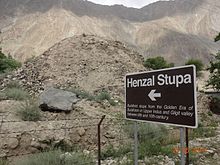
The Hanzal stupa dates from the Buddhist era.
According to Chinese records, between the 600s and the 700s, the city was governed by a Buddhist dynasty referred to as Trivial Balur or Lesser Bolü (Chinese: 小勃律).[9] They are believed to be the Patola Shahis dynasty mentioned in a Brahmi inscription,[10] and are devout adherents of Vajrayana Buddhism.[xi]
In mid-600s, Gilgit came under Chinese suzerainty later the fall of Western Turkic Khaganate due to Tang military campaigns in the region. In tardily 600s CE, the rising Tibetan Empire wrestled control of the region from the Chinese. However, faced with growing influence of the Umayyad Caliphate and and then the Abbasid Caliphate to the west, the Tibetans were forced to ally themselves with the Islamic caliphates. The region was then contested by Chinese and Tibetan forces, and their respective vassal states, until the mid-700s. Chinese record of the region last until late 700s at which time the Tang's western military machine campaign was weakened due to the An Lushan Rebellion.[12]
The control of the region was left to the Tibetan Empire. They referred to the region as Bruzha, a toponym that is consequent with the ethnonym "Burusho" used today. Tibetan control of the region lasted until late-800s CE.[13]
Gilgit manuscripts
This corpus of manuscripts was discovered in 1931 in Gilgit, containing many Buddhist texts such as four sutras from the Buddhist canon, including the famous Lotus Sutra. The manuscripts were written on birch bark in the Buddhist form of Sanskrit in the Sharada script. They cover a wide range of themes such as iconometry, folk tales, philosophy, medicine and several related areas of life and general knowledge.[14]
The Gilgit manuscripts[15] are included in the UNESCO Memory of the Earth annals.[16] They are amid the oldest manuscripts in the world, and the oldest manuscript drove surviving in Islamic republic of pakistan,[15] having major significance in the areas of Buddhist studies and the evolution of Asian and Sanskrit literature. The manuscripts are believed to take been written in the 5th to 6th centuries AD, though some more manuscripts were discovered in the succeeding centuries, which were besides classified as Gilgit manuscripts.
Many of the original manuscripts from Gilgit can be plant in the National Archives of India and the Pratap Singh Museum in Srinigar. Ii manuscripts collected by the orientalist Sir Aurel Stein are in the British Library in London.[17] They include a rare newspaper version of the Lotus Sutra.
Every bit of vi October 2014, 1 source claims that the part of the collection deposited at the Sri Pratap Singh Museum in Srinagar was irrecoverably destroyed during the 2014 India–Islamic republic of pakistan floods.[xviii]
Buddhas, devotees with Buddhist deities on the painted cover from Manuscript 3, Saṃghāṭa Sūtra, with a sample page, commissioned by Devaśirikā and Atthocasiṃgha, 627-628 CE. Gilgit.[19] [20]
Pre-Trakhàn

The old rulers had the championship of Ra, and at that place is a reason to suppose that they were at one time Hindus, merely for the terminal five centuries and a one-half they have been Moslems. The names of the Hindu Ras have been lost, with the exception of the last of their number, Shri Ba'dut. Tradition relates that he was killed by a Mohammedan adventurer, who married his daughter and founded a new dynasty, since called Trakhàn, from a celebrated Ra named Trakhan, who reigned most the commencement of the fourteenth century. The previous rulers—of whom Shri Ba'dut was the last—were chosen Shahreis.[22]
Trakhàn Dynasty
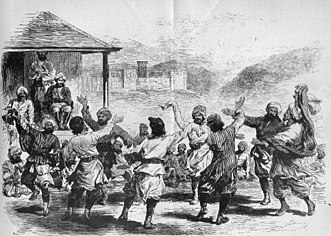
Gilgit was ruled for centuries by the local Trakhàn Dynasty, which concluded nearly 1810 with the decease of Raja Abas, the final Trakhàn Raja.[7] The rulers of Hunza and Nager also claim origin with the Trakhàn dynasty. They merits descent from a heroic Kayani Prince of Persia, Azur Jamshid (besides known every bit Shamsher), who secretly married the daughter of the king Shri Badat.
She conspired with him to overthrow her carnivorous father. Sri Badat's religion is theorised as Hindu by some[23] [24] and Buddhist past others.[25] [26] All the same, considering the region'due south Buddhist heritage, with the most recent influence being Islam, the most likely preceding influence of the region is Buddhism.
Prince Azur Jamshid succeeded in overthrowing King Badat who was known as the Adam Khor (literally "man-eater"),[27] [28] ofttimes demanding a child a solar day from his subjects, his demise is still celebrated to this very 24-hour interval by locals in traditional almanac celebrations.[29] In the beginning of the new year's day, where a Juniper procession walks along the river, in memory of chasing the cannibal king Sri Badat away.[xxx]
Azur Jamshid abdicated after sixteen years of rule in favour of his wife Nur Bakht Khatùn until their son and heir Garg, grew of age and causeless the championship of Raja and ruled, for 55 years. The dynasty flourished under the name of the Kayani dynasty until 1421 when Raja Torra Khan causeless rulership. He ruled as a memorable rex until 1475. He distinguished his family line from his stepbrother Shah Rais Khan (who fled to the male monarch of Badakshan, and with whose assistance he gained Chitral from Raja Torra Khan), as the now-known dynastic name of Trakhàn. The descendants of Shah Rais Khan were known as the Ra'issiya Dynasty.[31]
1800s
The period of greatest prosperity was probably nether the Shin Ras, whose dominion seems to accept been peaceable and settled. The whole population, from the Ra to the poorest subject lived by agriculture. According to tradition, Shri Buddutt'south rule extended over Chitral, Yassin, Tangir, Darel, Chilas, Gor, Astor, Hunza, Nagar and Haramosh all of which were held by tributary princes of the aforementioned family.[22]
The area had been a flourishing tract but prosperity was destroyed by warfare over the side by side l years, and past the bang-up flood of 1841 in which the river Indus was blocked past a landslip below the Hatu Pir and the valley was turned into a lake.[32] Afterwards the death of Abas, Sulaiman Shah, Raja of Yasin, conquered Gilgit. And then, Azad Khan, Raja of Punial, killed Sulaiman Shah, taking Gilgit; then Tahir Shah, Raja of Buroshall (Nagar), took Gilgit and killed Azad Khan.
Tair Shah's son Shah Sakandar inherited, only to be killed by Gohar Aman, Raja of Yasin of the Khushwakhte Dynasty when he took Gilgit. Then in 1842, Shah Sakandar'southward brother, Karim Khan, expelled Yasin rulers with the back up of a Sikh army from Kashmir. The Sikh general, Nathu Shah, left garrison troops and Karim Khan ruled until Gilgit was ceded to Gulab Singh of Jammu and Kashmir in 1846 by the Treaty of Amritsar,[7] and Dogra troops replaced the Sikh in Gilgit.
Nathu Shah and Karim Khan both transferred their allegiance to Gulab Singh, continuing local administration. When Hunza attacked in 1848, both of them were killed. Gilgit fell to the Hunza and their Yasin and Punial allies but was shortly reconquered past Gulab Singh'south Dogra troops. With the support of Raja Gohar Aman, Gilgit'southward inhabitants collection their new rulers out in an uprising in 1852. Raja Gohar Aman then ruled Gilgit until his death in 1860, only before new Dogra forces from Ranbir Singh, son of Gulab Singh, captured the fort and town.[7]
In the 1870s Chitral was threatened by Afghans, Maharaja Ranbir Singh was business firm in protecting Chitral from Afghans, the Mehtar of Chitral asked for help. In 1876 Chitral accepted the dominance of Jammu Clan and in reverse get the protection from the Dogras who accept in the past took role in many victories over Afghans during the time of Gulab Singh Dogra.[33]
British Raj
In 1877, in club to guard against the advance of Russian federation, the British Bharat Government, interim every bit the suzerain power of the princely state of Jammu and Kashmir, established the Gilgit Agency. The Agency was re-established under control of the British Resident in Jammu and Kashmir. It comprised the Gilgit Wazarat; the State of Hunza and Nagar; the Punial Jagir; the Governorships of Yasin, Kuh-Ghizr and Ishkoman, and Chilas.
The Tajiks of Xinjiang sometimes enslaved the Gilgiti and Kunjuti Hunza.[34]

In 1935, the British Bharat government demanded from the Jammu and Kashmir state to lease them Gilgit town plus most of the Gilgit Agency and the hill-states Hunza, Nagar, Yasin and Ishkoman for 60 years.[35]
Abdullah Sahib was an Arain and belonged to Chimkor Sahib village of Ambala commune Punjab, British India. Abdullah Sahib was the get-go Muslim governor of the Gilgit in British fourth dimension menstruum and was shut acquaintance of Maharaja Partap Singh.[36]
Khan Bahadur Kalay Khan, a Mohammed Zai Pathan, was the Governor of Gilgit Hunza and Kashmir before partition.
1947 Kashmir war
On 26 Oct 1947, Maharaja Hari Singh of Jammu and Kashmir, faced with a tribal invasion by Pakistan due to Masscre of Muslims in Jammu by Hindus and Sikh mobs, signed the Instrument of Accession, joining Republic of india.
Gilgit'southward war machine leaders did not favour the State's accretion to India.[37] The military machine leaders of the Frontier Districts Province (modern twenty-four hour period Gilgit-Baltistan) wanted to bring together Pakistan.[38] Sensing their discontent, Major William Brown, the Maharaja's commander of the Gilgit Scouts, mutinied on i November 1947, overthrowing the Governor Ghansara Singh.[39] The anemic coup d'etat was planned by Dark-brown to the final particular under the code proper name "Datta Khel", which was as well joined by a rebellious section of the Jammu and Kashmir sixth Infantry under Mirza Hassan Khan. Brown ensured that the treasury was secured and minorities were protected. A provisional regime (Aburi Hakoomat) was established past the Gilgit locals with Raja Shah Rais Khan equally the president and Mirza Hassan Khan equally the commander-in-principal. However, Major Chocolate-brown had already telegraphed Khan Abdul Qayyum Khan asking Pakistan to accept over. The Pakistani political agent, Khan Mohammad Alam Khan, arrived on 16 November and took over the assistants of Gilgit.[twoscore] [41] Brownish outmaneuvered the pro-Independence group and secured the approval of the mirs and rajas for accretion to Islamic republic of pakistan. Browns's actions surprised the British Authorities.[42]
The conditional authorities lasted 16 days. The conditional government lacked sway over the population. The Gilgit rebellion did not accept civilian involvement and was solely the work of war machine leaders, non all of whom had been in favor of joining Pakistan, at least in the short term. Historian Ahmed Hasan Dani mentions that although at that place was lack of public participation in the rebellion, sentiments were intense in the civilian population and their anti-Kashmiri sentiments were besides articulate.[43] Co-ordinate to various scholars, the people of Gilgit every bit well as those of Chilas, Koh Ghizr, Ishkoman, Yasin, Punial, Hunza and Nagar joined Pakistan by pick.[44] [45] [46] [47] [48]
Geography
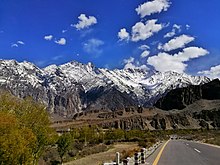
Gilgit is situated amongst some of the globe's near dramatic mountain scenery
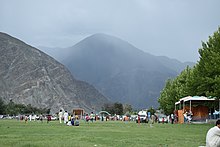
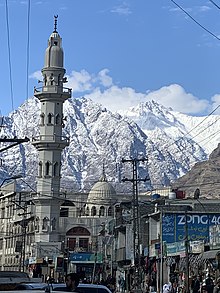
Jama Mosque located in Raja Bazar Road Gilgit
Gilgit is situated in a valley formed past the confluence of the Indus River, Hunza River and Gilgit River.
Climate
Gilgit experiences a cold desert climate (Köppen climate classification BWk). Atmospheric condition conditions for Gilgit are dominated by its geographical location, a valley in a mountainous area, southwest of Karakoram range. The prevalent season of Gilgit is winter, occupying the valley eight to nine months a year.
Gilgit lacks meaning rainfall, averaging in 120 to 240 mm (4.7 to 9.4 in) annually, as monsoon breaks confronting the southern range of Himalayas. Irrigation for land cultivation is obtained from the rivers, abundant with melting snow h2o from higher altitudes.
The summertime flavor is brief and hot, with daily high temperatures occasionally peaking at over 40 °C (104 °F). As a effect of this extremity in the weather, landslides and avalanches are frequent in the expanse.[ dubious ] [49]
| Climate data for Gilgit | |||||||||||||
|---|---|---|---|---|---|---|---|---|---|---|---|---|---|
| Month | January | Feb | Mar | April | May | Jun | Jul | Aug | Sep | Oct | Nov | December | Year |
| Tape loftier °C (°F) | 17.5 (63.5) | 22.0 (71.6) | 29.4 (84.ix) | 37.two (99.0) | 41.v (106.seven) | 43.5 (110.3) | 46.3 (115.three) | 43.eight (110.8) | 41.6 (106.ix) | 36.0 (96.8) | 28.0 (82.4) | 24.v (76.ane) | 46.3 (115.3) |
| Average high °C (°F) | 9.6 (49.3) | 12.vi (54.7) | 18.4 (65.1) | 24.2 (75.half-dozen) | 29.0 (84.2) | 34.2 (93.6) | 36.2 (97.ii) | 35.3 (95.5) | 31.8 (89.2) | 25.vi (78.one) | 18.4 (65.1) | 11.half-dozen (52.9) | 19.4 (66.ix) |
| Average low °C (°F) | −2.7 (27.i) | 0.iv (32.7) | v.4 (41.7) | 9.2 (48.6) | 11.8 (53.2) | 14.9 (58.8) | 18.ii (64.8) | 17.5 (63.5) | 12.4 (54.3) | 6.three (43.3) | 0.4 (32.7) | −ii.three (27.9) | 6.2 (43.2) |
| Record depression °C (°F) | −10.0 (14.0) | −viii.ix (sixteen.0) | −iii.0 (26.half dozen) | 1.1 (34.0) | 3.9 (39.0) | 5.one (41.two) | 10.0 (l.0) | 9.8 (49.6) | 3.0 (37.four) | −ii.5 (27.5) | −8.5 (xvi.7) | −11.one (12.0) | −11.1 (12.0) |
| Boilerplate rainfall mm (inches) | four.half-dozen (0.18) | vi.seven (0.26) | 11.eight (0.46) | 24.four (0.96) | 25.1 (0.99) | viii.9 (0.35) | 14.6 (0.57) | 14.9 (0.59) | viii.1 (0.32) | 6.3 (0.25) | 2.4 (0.09) | 5.1 (0.xx) | 107.8 (4.24) |
| Average relative humidity (%) (at 17:00 PST) | 51.3 | 34.6 | 26.seven | 27.half dozen | 26.half dozen | 23.vii | 29.viii | 36.8 | 36.seven | 42.2 | 49.1 | 55.0 | 36.vii |
| Source: Pakistan Meteorological Department[fifty] | |||||||||||||
Climatic change Effects
Climatic change has adversely effected this region with more rains every yr. On 26 August 2022, about villages in Ghizer district and Hunza were severely effected past the ongoing flooding displacing many people.
Administration
The city of Gilgit constitutes a tehsil within Gilgit District.[51]
Transportation


"Jeep" used to exist the widely used vehicle in the region till late 2000s
Air
Gilgit is served past the nearby Gilgit Drome, with direct flights to Islamabad. Pakistan International Airlines (PIA) is the merely airline operating in Gilgit. The Government of Islamic republic of pakistan is planning to build a new international standard drome in Gilgit to meet the requirements of international tourists and demand from domestic investors.[52]
Road

National Highway N-15 has precipitous direction changes which is a challenge for drivers who use this route to reach Gilgit
Gilgit is located approximately 10 km (6.2 mi) from the Karakoram Highway (KKH). The roadway is being upgraded every bit role of the China–Pakistan Economic Corridor. The KKH connects Gilgit to Chilas, Dasu, Besham, Mansehra, Abbottabad and Islamabad in the south. Gilgit is connected to Karimabad (Hunza) and Sust in the north, with further connections to the Chinese cities of Tashkurgan, Upal and Kashgar in Xinjiang. Gilgit is besides linked to Chitral in the west, and Skardu to the eastward. The route to Skardu will be upgraded to a 4-lane route at a toll of $475 1000000.[53]
Transport companies such every bit the Silk Route Transport Pvt, Masherbrum Transport Pvt and Northern Areas Transport Corporation (NATCO), offer rider road transport betwixt Islamabad, Gilgit, Sust, and Kashgar and Tashkurgan in China.
The Astore-Burzil Laissez passer Road, linking Gilgit to Srinagar was airtight in 1978.[54]
Runway
Gilgit is not served by any rails connections. Long-term plans for the China–Islamic republic of pakistan Economic Corridor call for structure of the 682 km (424 mi) long Khunjerab Railway, which is expected to be completed in 2030,[55] that would besides serve Gilgit.
-

-

Tunnels are mutual in Gilgit
Teaching
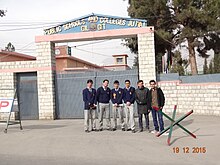
- Karakoram International Academy Gilgit
- Public Schools and Colleges Jutial Gilgit
- Aga Khan College Secondary School Gilgit
Bones Facilities

Sui Northern Gas Pipelines Limited Establish in Gilgit
Gilgit has not received a gas pipeline infrastructure since Islamic republic of pakistan'due south independence, dissimilar other cities. Through the importation of gas cylinders from other provinces, many private gas contractors offering gas cylinders. The LPG (Liquefied Petroleum Gas) Air Mix Establish projection by Sui Northern Gas Pipelines Limited was unveiled in 2020 with the goal of bringing the gas facility to Gilgit. This volition significantly reduce deforestation as public uses wood from copse for heating and lighting purpose. The first caput part has been built in Gilgit Urban center.[56]
Sis cities
- Skardu, Baltistan
- Kashgar, China (since May 2009)
-

This statue is fabricated to show the spirit of the Polo Sport. It is located at Jutial. Polo is played every year in the valley Shandoor.
-

I Love Gilgit sign made to evidence patriotism towards the region
-

Dumplingsm a.k.a. manto, are a widely eaten dish in the region
See besides
- Chamogarh
- Gilgit District
- Karakoram Highway
References
Citations
- ^ "Geography of Chitral". Chitralnews.com. Archived from the original on 4 March 2016. Retrieved half-dozen Nov 2015.
- ^ "Post Codes". Pakistan Post Office. Retrieved 17 March 2015.
- ^ "Gilgit | Kashmir region, Indian subcontinent, Asia". Encyclopedia Britannica . Retrieved xx June 2019.
- ^ paderbornersj (26 March 2017). "Welcome to 'Happyness': In aboriginal times Gilgit was known equally 'Sargin Gileet' which means the happy country of Gilgit in Shina language — Pamir Times Cyberspace". Paderborner 'SJ' Blog . Retrieved 27 Oct 2020.
- ^ Counterinsurgency, Democracy and the Politics of Identity in Islamic republic of pakistan
- ^ Counterinsurgency, Democracy and the Politics of Identity in Republic of india
- ^ a b c d Frederick Drew (1875) The Jummoo and Kashmir Territories: A Geographical Business relationship East. Stanford, London, OCLC 1581591
- ^ "Metropolitan Museum of Art". www.metmuseum.org.
- ^ Sen, Tansen (2015). Buddhism, Diplomacy, and Trade: The Realignment of India–China Relations, 600–1400. Rowman & Littlefield. ISBN9781442254732 . Retrieved 19 February 2017.
- ^ Schmidt, Ruth Laila; Kohistani, Razwal (2008). A Grammar of the Shina Language of Indus Kohistan. ISBN978-3447056762 . Retrieved 23 January 2018.
- ^ Twist, Rebecca L. (2007). Patronage, Devotion and Politics: A Buddhological Written report of the Patola Sahi Dynasty's Visual Record. Ohio State University. ISBN9783639151718 . Retrieved nineteen February 2017.
- ^ Stein, Mark Aurel (1907). Ancient Khotan: Detailed Report of Archaeological Explorations in Chinese Turkestan. Vol. one. Oxford, U.k.: Clarendon Press. pp. 4–18.
- ^ Mock, John (October 2013). "A Tibetan Toponym from Afghanistan" (PDF). Revue d'Études Tibétaines. Middle national de la recherche scientifique (27): v–9. ISSN 1768-2959. Retrieved 22 January 2018.
- ^ "BBC News – India: Rare Buddhist manuscript Lotus Sutra released". Bbc.co.uk. three May 2012. Retrieved 22 November 2013.
- ^ a b Gyan Marwah (August 2004). "Gilgit Manuscript — Piecing Together Fragments of History". The South Asian Mag. Haryana, Republic of india. Retrieved 6 February 2014.
- ^ "Gilgit Manuscript | United Nations Educational, Scientific and Cultural Arrangement". unesco.org . Retrieved 31 July 2018.
- ^ IDP website
- ^ "Kashmir floods damage 2000-year-old Buddhist treasures". www.dnaindia.com. 3 October 2014. Retrieved 6 October 2014.
- ^ Twist, Rebecca L. (2018). "Images of the Crowned Buddha along the Silk Road: Iconography and Ideology". Humanities. seven (iv): 92. doi:10.3390/h7040092.
- ^ von Hinüber, Oskar, Professor Emeritus, University of Freiburg. "Bronzes of the Ancient Buddhist Kingdom of Gilgit". world wide web.metmuseum.org.
- ^ Flood, Finbarr Barry (2017). A Turk in the Dukhang? Comparative Perspectives on Elite Clothes in Medieval Ladakh and the Caucasus. Austrian Academy of Science Press. p. 231.
- ^ a b John Bidduph (2004) Tribes of the Hindoo Koosh, Adamant Media Corporation, ISBN 1402152728, pp. 20–21
- ^ Amar Singh Chohan (1984) The Gilgit Agency, 1877–1935, Atlantic Publishers & Distributors, p. 4
- ^ Reginald Charles (1976) Between the Oxus and the Indus, Francis Schomberg, p. 249
- ^ Henry Osmaston, Philip Denwood (1995) Recent Enquiry on Ladakh 4 & 5: Proceedings of the Fourth and Fifth, Motilal Banarsidass, p. 226
- ^ Ahmad Hasan Dani (1989) History of Northern Areas of Pakistan, Islamabad : National Constitute of Historical and Cultural Inquiry, p. 163
- ^ Imperial Gazetteer of Bharat. Provincial Series: Kashmir and Jammu, ISBN 0-543-91776-two, Determined, p. 107
- ^ Reginald Charles (1976) Between the Oxus and the Indus, Francis Schomberg, p. 144
- ^ [1] [ expressionless link ]
- ^ Henry Osmaston, Philip Denwood (1995) Recent Enquiry on Ladakh four & 5, Motilal Banarsidass Publ., p. 229
- ^ Ahmad Hasan Dani (1999) History of Civilizations of Fundamental Asia, Motilal Banarsidass Publ, pp. 216–217
- ^ "Imperial Gazetteer2 of India, Volume 12 – Imperial Gazetteer of India – Digital Southern asia Library". Dsal.uchicago.edu. 18 February 2013. p. 238. Retrieved 22 November 2013.
- ^ Prakash Nanda (2007). Ascent India: Friends and Foes. Lancer Publishers. p. 167. ISBN978-0-9796174-1-6.
- ^ Sir Thomas Douglas Forsyth (1875). Report of a mission to Yarkund in 1873, under command of Sir T. D. Forsyth: with historical and geographical information regarding the possessions of the ameer of Yarkund. Printed at the Foreign department press. p. 56.
- ^ Bangash, 3 Forgotten Accessions 2010, p. 122.
- ^ Abdullah Sahib
- ^ Bangash 2010, p. 128: [Ghansara Singh] wrote to the prime minister of Kashmir: 'in case the Land accedes to the Indian Matrimony, the Gilgit province volition go to Islamic republic of pakistan', just no action was taken on it, and in fact Srinagar never replied to whatever of his messages. sfn error: multiple targets (two×): CITEREFBangash2010 (help)
- ^ Snedden, Christopher (2013). Kashmir-The Untold Story. HarperCollins Publishers India. ISBN9789350298985.
Similarly, Muslims in Western Jammu Province, specially in Poonch, many of whom had martial capabilities, and Muslims in the Borderland Districts Province strongly wanted J&M to join Islamic republic of pakistan.
- ^ Dark-brown, Gilgit Rebellion 2014, p. 264. sfn mistake: no target: CITEREFBrown,_Gilgit_Rebellion2014 (help)
- ^ Schofield 2003, pp. 63–64.
- ^ Bangash 2010 harvnb fault: multiple targets (2×): CITEREFBangash2010 (help)
- ^ Victoria Schofield (2000). Kashmir in Conflict: Republic of india, Islamic republic of pakistan and the Unending War. I.B.Tauris. pp. 63–64. ISBN978-1-86064-898-4.
- ^ Bangash, Yaqoob Khan (2010). "3 Forgotten Accessions: Gilgit, Hunza and Nagar". The Journal of Imperial and Commonwealth History. 38: 117–143. doi:x.1080/03086530903538269. S2CID 159652497.
- ^ Bangash, Yaqoob Khan (2010). "Iii Forgotten Accessions: Gilgit, Hunza and Nagar". The Journal of Imperial and Republic History. 38: 117–143. doi:10.1080/03086530903538269. S2CID 159652497.
- ^ Bangash, Yaqoob Khan (nine January 2016). "Gilgit-Baltistan—part of Islamic republic of pakistan by selection". The Express Tribune . Retrieved 5 Jan 2017.
Nearly 70 years ago, the people of the Gilgit Wazarat revolted and joined Islamic republic of pakistan of their own free volition, as did those belonging to the territories of Chilas, Koh Ghizr, Ishkoman, Yasin and Punial; the princely states of Hunza and Nagar also acceded to Pakistan. Hence, the fourth dimension has come to acknowledge and respect their choice of being full-fledged citizens of Pakistan.
- ^ Chitralekha Zutshi (2004). Languages of Belonging: Islam, Regional Identity, and the Making of Kashmir. C. Hurst & Co. Publishers. pp. 309–. ISBN978-i-85065-700-2.
- ^ Ershad Mahmud 2008, p. 24. sfn error: no target: CITEREFErshad_Mahmud2008 (assistance)
- ^ Sokefeld, Martin (November 2005), "From Colonialism to Postcolonial Colonialism: Changing Modes of Domination in the Northern Areas of Pakistan" (PDF), The Periodical of Asian Studies, 64 (4): 939–973, doi:10.1017/S0021911805002287, S2CID 161647755
- ^ Alam Zaib. "Somethings virtually Gilgit". Karachi, Pakistan. Retrieved 11 June 2009.
- ^ "Gilgit Climate Data". Pakistan Meteorological Department. Archived from the original on thirteen June 2010. Retrieved 11 January 2016.
- ^ Bukhari, Shahid Javed (2015). Historical Dictionary of Pakistan. Lahore: Lowman & Littlefield. p. 228.
- ^ "Govt planning new airport in Gilgit: Khan". The Express Tribune. 25 May 2021. Retrieved 27 May 2021.
- ^ "PM announces structure of Skardu-Gilgit road". Samaa Television. 24 November 2015. Retrieved iv July 2017.
- ^ Ibrahim Shahid (27 March 2004) Gilgit-Srinagar Road: Govt seeks NA admin's opinion. The Daily Times
- ^ "Havelian to Khunjerab railway track to be upgraded under China-Pakistan Economic Corridor". Sost Today. four July 2017. Retrieved 10 Feb 2016.
- ^ https://www.sngpl.com.pk/SNG_Megzines/112020/newsletter.pdf[ bare URL PDF ]
General sources
- Bangash, Yaqoob Khan (2010). "3 Forgotten Accessions: Gilgit, Hunza and Nagar". The Periodical of Imperial and Commonwealth History. 38 (1): 117–143. doi:x.1080/03086530903538269. S2CID 159652497.
- Schofield, Victoria (2003) [Beginning published in 2000], Kashmir in Disharmonize, London and New York: I. B. Taurus & Co, ISBN1860648983
Further reading
- Tribes of the Hindoo Koosh by John Biddulph.
- Festivals and Folklore of Gilgit by Ghulam Muhammad.
External links
![]()
- Official Website of the Gilgit Baltistan Tourism Department
- Official Website of the Regime of Gilgit Baltistan
- Gilgit Nomination, UNESCO, the Memory of the World Annals entry document
- Britannica Gilgit
-
 Gilgit travel guide from Wikivoyage
Gilgit travel guide from Wikivoyage
4 River Valley Civilizations Map,
Source: https://en.wikipedia.org/wiki/Gilgit
Posted by: richardswalouteemper.blogspot.com






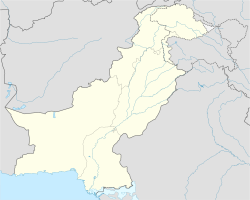



0 Response to "4 River Valley Civilizations Map"
Post a Comment